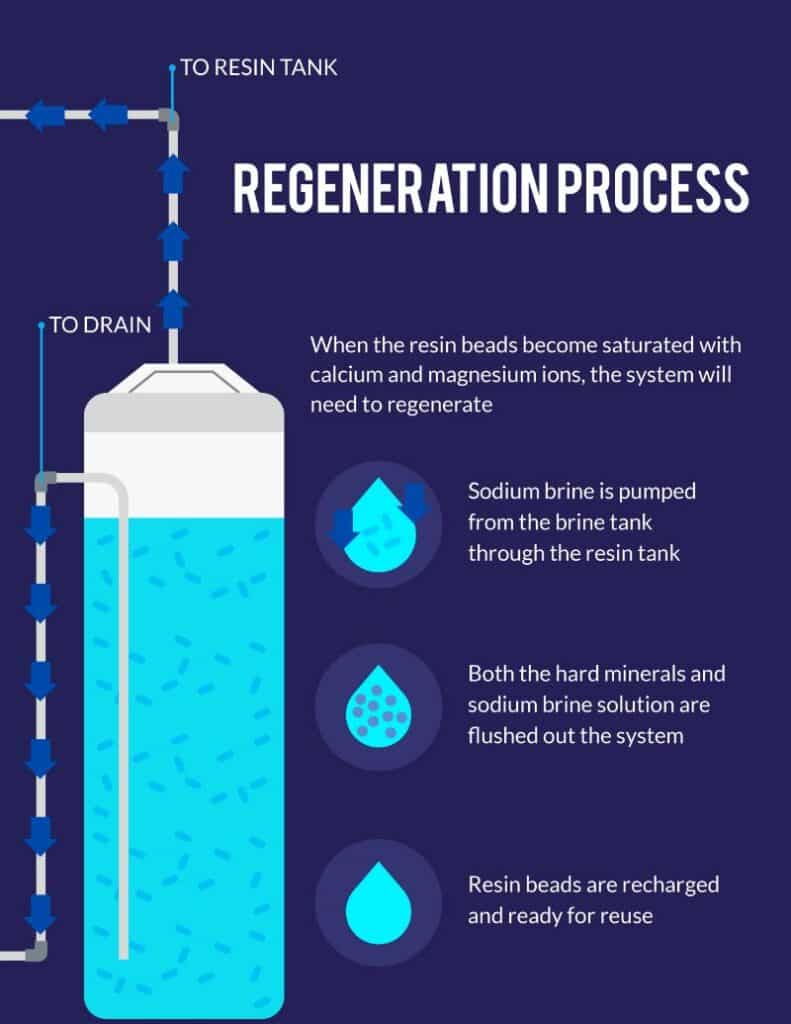
During recharge, the softener is automatically put in bypass mode, allowing hard water to be available to the home during this process. Once the softener is recharged, water is again directed through the resin bed to be conditioned (softened).
The regeneration process flushes minerals from your water softener’s resin beads. Without this process, those beads would become too heavily inundated with minerals to function properly.
Why does a water softener regenerate?
In ion-exchange water softeners, hard water is passed through a bed of resin beads. As the hardness minerals in water, such as calcium and magnesium, come in contact with the resin. As hard water passes through the bed, each bead attracts and holds the minerals in the water that make it “hard.” This is called “ion-exchanging,” and works much like a magnet attracting and holding metals. Soft water (without hard minerals) then continues to flow from the water softening system to the house water pipes.
Over time, as the hardness minerals are trapped in the resin, the resin fills up and the system will regenerate or recharge to remove the trapped hardness minerals so it can start the softening process again. Demand regeneration is often considered more efficient in both salt and water usage because the system only regenerates when it meets a pre-set softening capacity instead of simply regenerating on a given day, whether it needs regeneration or not.
How long does a water softener take to regenerate?
Most water softeners are programmed to recharge at 2:00 am – 4 am, when homeowners are not using water. Regeneration takes approximately 2 hours to complete. The frequency of how often the water softener will recharge depends on factors like water hardness level and household water usage. The water softener has a reserve capacity of 20% to 25% before it regenerates; this means that it regenerates when the resin beads are 75% to 80% saturated (filled with hardness minerals).
How many gallons of water does it take to regenerate?
 During regeneration, a typical water softener for a family of 4 uses approximately 35 to 65 gallons of water, depending on the size of the water softener. While going through regeneration, the motor will not run constantly, it will go through several starts and stops, which explains the noise you hear in the middle of the night.
During regeneration, a typical water softener for a family of 4 uses approximately 35 to 65 gallons of water, depending on the size of the water softener. While going through regeneration, the motor will not run constantly, it will go through several starts and stops, which explains the noise you hear in the middle of the night.
The amount of water used during softener regeneration also varies depending on the hardness of the water. Some softeners may use between 20 to 25 gallons of water during regeneration. Although this might seem like a lot of water, the process saves you the water that could be wasted if you keep using hard water or even damage to your home appliances.
How often should my water softener regenerate?
How often a water softener will regenerate or recharge, is controlled by the valve of a water softener system. The valve or “control valve” is the ‘brain’ of the softener unit, since it gives the commands as to when the softener regeneration process will occur
Your water softener could regenerate once per month or several times a day. This will all depend on the capacity of your water softener, the volume of water that is used and the characteristics of the water being treated.
For example: A mid-sized water softener treating water with a total hardness of 10 Grains Per Gallon (GPG) for a home with a family of 4 will have to regenerate about once every 10 days. This is based on the average adult using approximately 75 gallons of water per day with a water softener that has a capacity of 32,000 grains.
So as you can see, how often your water softener will regenerate depends on several factors, any one of which can change how often your water softener will need to regenerate!
Can water be used during water softener regeneration?
Using water during regeneration is possible but may cause some adverse effects, especially if you have a single tank system because while the softener is regenerating, you may be letting hard water into your home. Best practices are to set your softener regeneration to midnight or early hours of the morning to avoid using water while the softener is regenerating. If you have to, you should use only small amounts of water during regeneration like flushing, washing hands, or drinking. You should definitely postpone your laundry or bath until after the softener has finished regenerating!
Sources:
https://www.aquatell.ca/blogs/aquatell/how-much-water-does-it-take-to-regenerate-a-water-softener